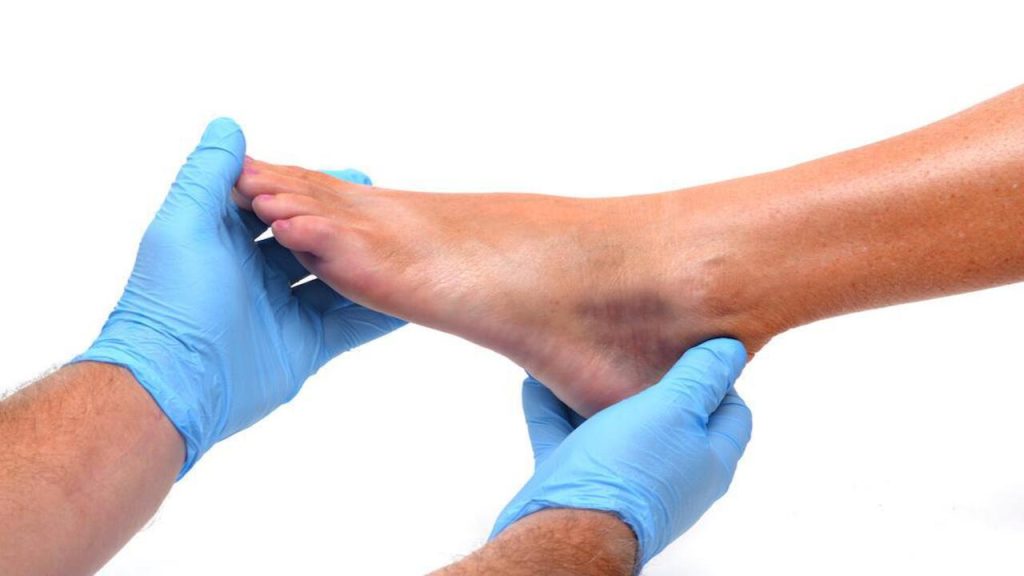Ankle sprains occur when the ligaments that connect the ankle bones are stretched or torn, causing pain, swelling, and difficulty walking. While some ankle sprains may heal quickly, others may take longer to fully recover.
Understanding the healing process of an ankle sprain is important for anyone who has suffered from this injury.
The length of time it takes for an ankle sprain to heal depends on various factors, including the severity of the injury and the treatment plan followed.
In this article, we will explore the typical healing timeline for ankle sprains and the steps you can take to speed up the healing process.
What are ankle sprains and why they are common?
Ankle sprains are a common injury that occurs when the ligaments in the ankle are stretched or torn. They can happen during physical activities such as sports or simply walking on uneven surfaces.
The ankle joint is particularly vulnerable to sprains because it supports the weight of the body and is constantly in motion. Symptoms of an ankle sprain include pain, swelling, and difficulty moving the ankle.
It is important to seek medical attention if you suspect you have an ankle sprain to ensure proper treatment and prevent further injury.
Difference between an ankle sprain and a broken ankle
An ankle sprain occurs when the ligaments that connect the bones in the ankle are stretched or torn due to a sudden twist or turn.
This can cause pain, swelling, and difficulty walking, but typically does not result in a deformity or noticeable change in the shape of the ankle.
On the other hand, a broken ankle involves a fracture in one or more of the bones that make up the ankle joint. This can also cause pain and swelling, but may also result in a visible deformity or difficulty bearing weight on the affected foot.
It is important to seek medical attention for both ankle sprains and broken ankles to ensure proper treatment and avoid further injury.
How Long Does Ankle Sprain Take To Heal?

1. Grade 1 Ankle Sprain
A grade 1 ankle sprain is the mildest form of ankle sprain and involves stretching or slight tearing of the ligaments. Healing time for this type of ankle sprain is typically 1-3 weeks.
2. Grade 2 Ankle Sprain
A grade 2 ankle sprain involves a partial tear of the ligament and can result in moderate pain, swelling, and bruising. Healing time for this type of ankle sprain is typically 3-6 weeks.
3. Grade 3 Ankle Sprain
A grade 3 ankle sprain is the most severe form of ankle sprain and involves a complete tear of the ligament.
This can result in severe pain, swelling, and bruising, and may require surgery in some cases. Healing time for this type of ankle sprain can take up to 12 weeks or longer.
4. Inversion Ankle Sprain
An inversion ankle sprain occurs when the foot rolls inward, causing damage to the ligaments on the outside of the ankle. This is the most common type of ankle sprain and typically involves a grade 1 or grade 2 injury.
5. Eversion Ankle Sprain
An eversion ankle sprain occurs when the foot rolls outward, causing damage to the ligaments on the inside of the ankle. This type of ankle sprain is less common than an inversion sprain and can range from a grade 1 to grade 3 injury.
6. High Ankle Sprain
A high ankle sprain involves damage to the ligaments that connect the tibia and fibula bones in the leg.
This type of ankle sprain is less common than other types and can take longer to heal, with a recovery time of 6-12 weeks or longer.
7. Syndesmotic Ankle Sprain
A syndesmotic ankle sprain involves damage to the syndesmotic ligament that connects the tibia and fibula bones. This type of ankle sprain is less common than other types and can take longer to heal, with a recovery time of 6-12 weeks or longer.
Knowing the different types of ankle sprains and their healing timeframes can help you better understand the severity of your injury and how long it may take for you to fully recover.
It is important to seek medical attention if you experience severe pain, swelling, or bruising, or if your symptoms do not improve with rest and home treatments.
Factors that may affect healing time, such as age and overall health
Here are some Factors that may affect healing time, such as age and overall health
1. Severity of the sprain
The severity of an ankle sprain can vary from mild to severe, and this can greatly affect the healing time. A mild sprain may only take a few days to heal, while a severe sprain may take several weeks or even months.
2. Age
Age can also play a role in the healing time of an ankle sprain. Younger people may heal faster due to their higher metabolic rate, while older adults may experience a slower healing process due to a decrease in cell regeneration.
3. Overall health
Overall health can also affect the healing time of an ankle sprain. People who have pre-existing medical conditions or a weakened immune system may experience a longer healing time.
4. Treatment
The type of treatment received for an ankle sprain can also affect the healing time. Rest, ice, compression, and elevation (RICE) therapy is a common treatment for ankle sprains, but more severe cases may require physical therapy or even surgery.
5. Rehabilitation
Rehabilitation is an important part of the healing process for an ankle sprain. If proper rehabilitation is not done, the ankle may not fully heal, leading to chronic pain and instability.
6. Genetics
Genetics can also play a role in the healing time of an ankle sprain. Some people may have a genetic predisposition to slower healing times.
7. Lifestyle factors
Lifestyle factors such as smoking, poor nutrition, and lack of exercise can also affect the healing time of an ankle sprain. These factors can decrease blood flow and slow down the healing process.
Tips for promoting healing and reducing recovery time
1. Get plenty of rest
One of the most important things you can do to promote healing and reduce recovery time is to get plenty of rest. This means getting enough sleep each night, as well as taking time to rest and relax during the day.
2. Stay hydrated
Drinking plenty of water is also essential for promoting healing and reducing recovery time. Water helps to flush toxins out of the body and keeps the body hydrated, which is important for maintaining healthy cells and tissues.
3. Eat a healthy diet
Eating a healthy diet that is rich in nutrients is another important way to promote healing and reduce recovery time. This means eating plenty of fruits and vegetables, lean proteins, and healthy fats.
4. Take supplements
Taking supplements can also help to promote healing and reduce recovery time. Some supplements that may be helpful include vitamin C, vitamin D, and omega-3 fatty acids.
5. Avoid smoking and alcohol
Smoking and alcohol can both slow down the healing process and increase recovery time. If you are recovering from an injury or illness, it is best to avoid smoking and alcohol until you are fully healed.
6. Use heat or ice therapy
Heat and ice therapy can also be helpful for promoting healing and reducing recovery time.
Ice therapy can help to reduce inflammation and swelling, while heat therapy can help to improve blood flow and promote healing.
7. Follow your doctor’s instructions
Finally, it is important to follow your doctor’s instructions when it comes to promoting healing and reducing recovery time.
This may include taking medication, attending physical therapy, or following a specific diet or exercise plan.
By following your doctor’s instructions, you can ensure that you are doing everything possible to promote healing and reduce recovery time.
Exercises to heal ankle sprains
1. Ankle Circles
Ankle circles are a great exercise to help heal ankle sprains. Sit on a chair or bench with your foot off the ground. Slowly move your ankle in a circular motion, first clockwise and then counterclockwise. Do this for about 30 seconds, then switch to the other ankle.
2. Toe Raises
Toe raises are another great exercise to help heal ankle sprains. Stand with your feet shoulder-width apart and place your hands on a wall or chair for balance.
Slowly raise your heels off the ground and hold for a few seconds, then slowly lower them back down. Repeat this exercise for about 10-15 reps.
3. Heel Raises
Heel raises are the opposite of toe raises and can also help heal ankle sprains. Stand with your feet shoulder-width apart and place your hands on a wall or chair for balance.
Slowly raise your toes off the ground and hold for a few seconds, then slowly lower them back down. Repeat this exercise for about 10-15 reps.
4. Resistance Band Exercises
Resistance band exercises can help strengthen the ankle and prevent future ankle sprains. Sit on the ground with your legs straight out in front of you and loop a resistance band around the ball of your foot.
Slowly flex your foot towards your body, then slowly point it away from your body. Repeat this exercise for about 10-15 reps, then switch to the other foot.
5. Balance Exercises
Balance exercises can help improve the stability of your ankle and prevent future ankle sprains. Stand on one foot with your eyes closed and try to maintain your balance for about 30 seconds. Repeat this exercise on the other foot.
6. Calf Stretches
Calf stretches can help improve the flexibility of your ankle and prevent future ankle sprains. Stand facing a wall with your hands on the wall for balance. Step back with one foot and keep your heel on the ground.
Lean forward until you feel a stretch in your calf muscle. Hold for about 30 seconds, then switch to the other foot.
7. Achilles Tendon Stretches
Achilles tendon stretches can also help improve the flexibility of your ankle and prevent future ankle sprains. Stand facing a wall with your hands on the wall for balance.
Step back with one foot and keep your heel on the ground. Lean forward until you feel a stretch in your Achilles tendon. Hold for about 30 seconds, then switch to the other foot.
Conclusion
In conclusion, the healing time for an ankle sprain can vary depending on the severity of the injury. Mild sprains may take only a few days to a week to heal, while more severe sprains can take several weeks or even months.
It is important to follow the recommended treatment plan, which may include rest, ice, compression, and elevation, as well as physical therapy and rehabilitation exercises.
With proper care and patience, most ankle sprains will eventually heal and allow you to return to your normal activities.


